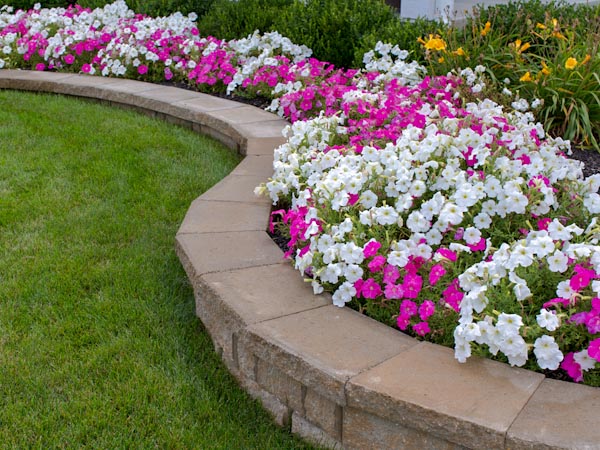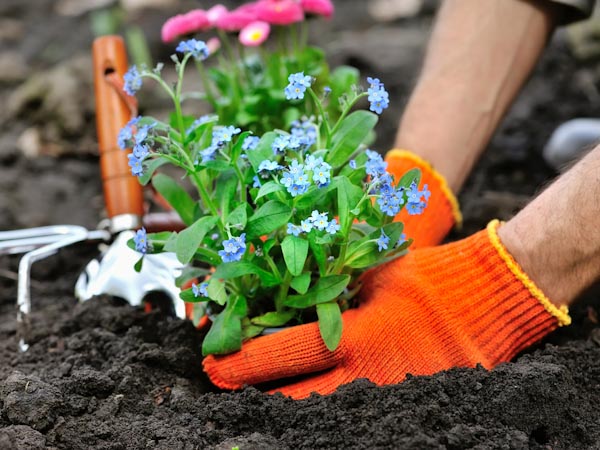Levi Reeves - April 18, 2023
Flower Bed Fabric - Why Your Garden Needs It
Flower beds are an essential part of any beautiful landscape design. They provide color, texture, and fragrance to your outdoor space while also attracting pollinators and adding visual interest to your yard. Whether you own a small balcony or a large backyard, flower beds can be a great way to enhance your outdoor environment and create a more welcoming and inviting atmosphere.
The best thing about flower beds is that they can be crafted into a variety of shapes and sizes. From raised beds to container gardens, there are endless possibilities for creating a beautiful and functional flower bed that fits your style and needs.
However, maintaining healthy flower beds can be a challenging task. Poor soil quality, erosion, weed growth, and pests can all impact the health and longevity of your flower bed.

Quick Summary
What is it?
Flower Bed Fabric is used to block weeds, provide soil separation, and for erosion control in flower beds and gardens. It is also known as geotextile fabric, landscape fabric, or garden fabric.
Why use it?
It can help block weeds, provide separation between soil and mulch, while allowing water and air to flow through.
How to install it?
Clear the area, level the soil, roll out the fabric and secure it down, and then cut holes in the fabric to put the flowers in.
Flower bed fabric, also know as garden fabric, is a helpful product to address these common issues. Geotextile fabric is a special material that has been used widely used in construction and landscaping. It helps soil retention and protect against erosion. When applied to flower beds, geotextile fabric can provide numerous benefits that improve the health and appearance of your garden.
In this article, we'll explore what geotextile fabric is, the different types available, and how it can benefit your flower beds. We'll also provide tips on how to use geotextile fabric effectively in your garden to maximize its benefits.
Garden Fabric and its Potential Benefits for Flower Beds
Geotextile fabric is a material that has gained popularity in the gardening world for its ability to improve soil quality. It protects flower beds from issues of soil erosion, weed growth, and pests. Garden fabric is made from synthetic materials including polyester or polypropylene. It is very durable, permeable, and resistant to decay.
When used in flower beds, geotextile fabric can offer several benefits:
- It can improve soil drainage and aeration, which is critical for healthy root development and overall plant growth.
- It can prevent soil erosion by stabilizing the soil and preventing it from being washed away by rainfall or irrigation.
- Geotextile fabric can suppress weed growth by blocking sunlight and preventing weed seeds from germinating. Finally, the fabric can protect flower beds from pests and animals, which can damage or destroy plants.

Backyard Landscaping Project

Flower Bed Fabric Installation
What is Flower Bed Fabric?
Geotextile fabric is a material that is commonly used in construction and landscaping projects to help stabilize and protect soil. It is manufactured industrially by weaving synthetic fibers or by bonding them together using heat or chemicals.
The fibers used in geotextile fabric are made from synthetic materials such as polyester, polypropylene, and nylon. These fibers are durable and resistant to environmental factors like sunlight, temperature and moisture. There are some non-synthetic geotextile fabric as well such as made from jute, however, with lower service life.
Geotextile fabric can last for many.years, often up to 20 years depending on the specific application and environmental conditions. However, the lifespan of the fabric can vary depending on factors like exposure to UV light, soil pH levels, and the presence of chemicals or other substances in the soil.
Garden fabric is available in two main types:
- Woven
- Non-Woven
Each type has unique characteristics that make it suitable for specific applications.
Woven Geotextile Fabric
Woven geotextile fabric is made by weaving synthetic fibers together in a regular pattern, much like a traditional fabric. This creates a strong and durable material that can resist tearing and puncturing.
Woven fabric is ideal for applications where high strength and stability are required, such as for stabilizing soil and preventing erosion. Because woven fabric has a uniform structure, it can provide a consistent level of filtration and allow for water to flow through while keeping soil and other materials in place.

Constructing a Raised Flower Bed

Garden Fabric Installation
Non-Woven Geotextile Fabric
Non-woven geotextile fabric, on the other hand, is created by bonding synthetic fibers together without weaving them. This results in a more flexible material that is resistant to tearing, but still provides excellent filtration and erosion control properties.
Non-woven fabric is often used for weed control, as it can block the growth.of weeds while still allowing water to pass through. The open structure of non-woven fabric can also allow for air and moisture to penetrate, which can be beneficial for plant growth.
Heavy-Duty Weed Barrier Fabric
All weed barrier is the same right? Wrong! Weed barrier often gets a bad rap because of the cheap stuff you can go pickup at your local garden center. No weed barrier is 100% effective but if you use the right stuff the amount of weeds in your landscape will be greatly reduced. We sell the right stuff.
View our Weed Barrier Fabric Sizes and Pricing
Importance of Characteristics of Flower Bed Fabric
The characteristics of geo fabric are important because they determine the fabric's ability to perform its intended function. For example, woven fabric is ideal for stabilizing soil because of its high strength and uniform structure, while non-woven fabric is better suited for filtration and weed control due to its flexibility and high drainage capabilities.
The characteristics of garden fabric play a crucial role in determining its effectiveness in a flower bed. When choosing the right type of geotextile fabric for your flower bed, it is important to consider factors such as permeability, durability, and strength.

Garden Fabric for Landscaping

Constructing Raised Garden Beds
- Permeability refers to the ability of the fabric to allow water and air to flow through it. A geotextile fabric with good permeability will allow water to drain freely from the soil, preventing it from becoming waterlogged and promoting healthy root growth. This is important for maintaining the health of your flowers and preventing the growth of mold and mildew in the soil.
- Durability is another important factor to consider when choosing geotextile fabric for your flower bed. The fabric should be able to withstand the elements and the wear and tear that comes with regular use. A durable fabric will resist tearing and puncturing, and will maintain its strength over time.
- Strength is also crucial when it comes to geotextile fabric. The fabric should be able to support the weight of the soil and plants in the flower bed without stretching or tearing. This is particularly important for larger flower beds or beds with heavy or dense soil.
Other factors to consider include UV resistance, which helps to prevent the fabric from breaking down over time due to exposure to sunlight, and chemical resistance, which helps to protect the fabric from degradation caused by exposure to chemicals in the soil.
3 Core Benefits of Geotextile Fabric in Flower Beds
Garden fabric can offer several benefits when used in flower beds. Here are some of the main advantages:
- Improved Drainage and Aeration of Soil - One of the key benefits of using geotextile fabric in flower beds is improved drainage and aeration of the soil. The fabric allows water to pass through freely, which can prevent water from pooling and causing root rot or other issues. Additionally, the fabric can help keep the soil loose and well-aerated, which can promote healthy root growth.
- Prevention of Soil Erosion and Weed Growth - Another significant benefit of geotextile fabric in flower beds is its ability to prevent soil erosion and weed growth. The fabric acts as a barrier, preventing soil from washing away during heavy rainfall or other weather events. Additionally, it can block the growth of weeds by preventing sunlight from reaching the soil, which can save you time and effort in maintaining your flower bed.
- Protection of Flower Bed from Pests and Animals - Geotextile fabric can also offer protection for your flower bed from pests and animals. The fabric acts as a barrier to prevent rodents and other animals from digging through the soil and damaging your plants. Additionally, it helps prevent insects and other pests from infesting your flower bed.

Backyard Landscaped Area

Gardener Pulling Weeds
How to Use Geotextile Fabric in Flower Beds
Following is a stepwise guideline to use fabric in flower beds.
Choosing the Right Type of Geotextile Fabric for Your Flower Bed
The first step in using geotextile fabric in your flower bed is choosing the right type of fabric. As discussed earlier, there are two main types.of geotextile fabric: woven ad non-woven. You should choose the type of fabric based on your specific needs and the type of soil you have in your flower bed.
- Woven geotextile fabric is a great choice if you have heavy or rocky soil, as it is strong and durable.
- Non-woven geotextile fabric, on the other hand, is more flexible and is a good choice for lighter soils.
Preparation of Soil and Installation of Fabric
Once you've chosen the right type of geotextile fabric for your flower bed, it's time to prepare the soil and install the fabric. Here are the steps you should follow:
- Clear the area: Remove any existing plants, rocks, or other debris from the area where you plan to install the geotextile fabric.
- Level the soil: Use a rake or shovel to level the soil in the flower bed.
- Install the geotextile fabric: Lay the fabric over the soil, making sure it covers the entire area of the flower bed. Be sure to overlap the edges of the fabric by at least 6 inches to ensure complete coverage.
- Secure the fabric: Use landscape staples or pins to secure the fabric in place. Place the pins about every 2-3 feet around the perimeter of the flower bed and along any seams where pieces of fabric overlap.
Planting Flowers and Maintaining the Bed
Once the geotextile fabric is installed, it's time to plant your flowers and maintain the bed. Here are some tips to keep in mind:
- Cut holes in the fabric: Use a utility knife to cut holes in the fabric where you want to plant your flowers. Be sure to make the holes just large enough to accommodate the plants.
- Plant the flowers: Add soil to the holes and plant your flowers. Be sure to water them thoroughly after planting.
- Mulch the bed: Cover the bed with a layer of mulch to help retain moisture and prevent weed growth.
- Maintain the bed: Regularly water and fertilize your flowers, and remove any weeds that do manage to sprout up. With proper care, your flower bed should thrive and look beautiful for years to come.

Planting Flowers
Conclusion
In conclusion, using flower bed fabric in flower beds can greatly enhance their health and appearance. By preventing soil erosion and weed growth, improving soil drainage and aeration, and protecting against pests and animals, flower beds can thrive with the help of geotextile fabric.
To get started on improving your own flower beds, it's important to choose the right type of geotextile fabric for your specific needs. Be sure to consider factors like durability, permeability, and the weight of the fabric.
Then, prepare the soil and install the fabric according to the manufacturer's instructions. This typically involves laying the fabric down over the soil, cutting it to size, and securing it in place with landscape staples or other anchoring methods.
Finally, plant your flowers and maintain the bed as usual. Over time, you should notice healthier plants and less maintenance required.
